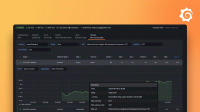Caution
Grafana Alloy is the new name for our distribution of the OTel collector. Grafana Agent has been deprecated and is in Long-Term Support (LTS) through October 31, 2025. Grafana Agent will reach an End-of-Life (EOL) on November 1, 2025. Read more about why we recommend migrating to Grafana Alloy.
This is documentation for the next version of Agent. For the latest stable release, go to the latest version.
Run Grafana Agent Flow as a standalone binary
If you downloaded the standalone binary, you must run Grafana Agent Flow from a terminal or command window.
Start Grafana Agent Flow on Linux, macOS, or FreeBSD
To start Grafana Agent Flow on Linux, macOS, or FreeBSD, run the following command in a terminal window:
AGENT_MODE=flow <BINARY_PATH> run <CONFIG_PATH>Replace the following:
<BINARY_PATH>: The path to the Grafana Agent Flow binary file.<CONFIG_PATH>: The path to the Grafana Agent Flow configuration file.
Start Grafana Agent Flow on Windows
To start Grafana Agent Flow on Windows, run the following commands in a command prompt:
set AGENT_MODE=flow
<BINARY_PATH> run <CONFIG_PATH>Replace the following:
<BINARY_PATH>: The path to the Grafana Agent Flow binary file.<CONFIG_PATH>: The path to the Grafana Agent Flow configuration file.
Set up Grafana Agent Flow as a Linux systemd service
You can set up and manage the standalone binary for Grafana Agent Flow as a Linux systemd service.
Note
These steps assume you have a default systemd and Grafana Agent Flow configuration.
To create a new user called
grafana-agent-flowrun the following command in a terminal window:sudo useradd --no-create-home --shell /bin/false grafana-agent-flowCreate a service file in
/etc/systemd/systemcalledgrafana-agent-flow.servicewith the following contents:[Unit] Description=Vendor-neutral programmable observability pipelines. Documentation=https://grafana.com/docs/agent/latest/flow/ Wants=network-online.target After=network-online.target [Service] Restart=always User=grafana-agent-flow Environment=HOSTNAME=%H EnvironmentFile=/etc/default/grafana-agent-flow WorkingDirectory=<WORKING_DIRECTORY> ExecStart=<BINARY_PATH> run $CUSTOM_ARGS --storage.path=<WORKING_DIRECTORY> $CONFIG_FILE ExecReload=/usr/bin/env kill -HUP $MAINPID TimeoutStopSec=20s SendSIGKILL=no [Install] WantedBy=multi-user.targetReplace the following:
<BINARY_PATH>: The path to the Grafana Agent Flow binary file.<WORKING_DIRECTORY>: The path to a working directory, for example/var/lib/grafana-agent-flow.
Create an environment file in
/etc/default/calledgrafana-agent-flowwith the following contents:## Path: ## Description: Grafana Agent Flow settings ## Type: string ## Default: "" ## ServiceRestart: grafana-agent-flow # # Command line options for grafana-agent # # The configuration file holding the Grafana Agent Flow configuration. CONFIG_FILE="<CONFIG_PATH>" # User-defined arguments to pass to the run command. CUSTOM_ARGS="" # Restart on system upgrade. Defaults to true. RESTART_ON_UPGRADE=trueReplace the following:
<CONFIG_PATH>: The path to the Grafana Agent Flow configuration file.
To reload the service files, run the following command in a terminal window:
sudo systemctl daemon-reloadUse the Linux systemd commands to manage your standalone Linux installation of Grafana Agent Flow.



